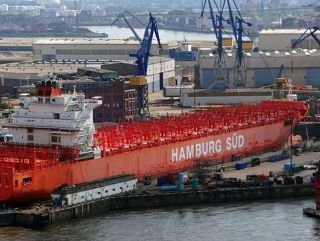 The cooperation recently forged between Hamburg Sud and United Arab Shipping Company (UASC), unlike the proposed alliances 2M and Ocean Three which are focused on cost reduction and economies of scale, is based more on mutual support in opening up new trades for each line as they pursue “grand expansion plans,” said a new report from Drewry.
The cooperation recently forged between Hamburg Sud and United Arab Shipping Company (UASC), unlike the proposed alliances 2M and Ocean Three which are focused on cost reduction and economies of scale, is based more on mutual support in opening up new trades for each line as they pursue “grand expansion plans,” said a new report from Drewry.
The terms of the agreement are vague, but Hamburg Sud is set to take slots from UASC in the Asia-North Europe trade by December 2014 and in the Asia-U.S. lane by January 2015, while UASC will enter the Asia-East Coast South America and Europe-ECSA trades from mid-2015.
The carriers added that discussions are planned that will potentially expand the geographic scope and even extend the nature of the agreement from its initial slot exchange parameters to include vessel-sharing on services.
Were the agreement to start today, Hamburg Sud could take space on up to five weekly Asia-North Europe services in which UASC participates, or just two loops if access is restricted to services in which UASC provides vessels, said Drewry.
For the Asia-USWC trade, UASC is involved on four services, two of which it contributes vessels to, while it currently has just the one Asia-USEC loop that includes UASC chartered-in tonnage.
When Ocean Three becomes operational, Hamburg Sud could theoretically offer space to shippers on four Asia-North Europe loops, five Asia-USWC services, and two Asia-USEC strings, one of which via the Suez Canal and one via the Panama Canal.
In return, from mid-2015 UASC will potentially have access to five Asia-ECSA services and three Europe-ECSA loops, or two and one respectively if slots are limited to Hamburg Sud-deployed services.
UASC does already have a very small presence in the Europe-ECSA trade as it takes space on the SAM service of MSC to and from the Mediterranean.
“The Hamburg Sud-UASC agreement differs from the likes of 2M and Ocean Three in that it opens doors to new trades and as such each carrier will lean heavily on the other for guidance as they find their feet in new land,” said Drewry.
“Despite having no obvious connections, either culturally or through previous service agreements, Hamburg Sud and UASC do share one important trait that could have drawn them to one another. Both companies are expansion minded.”
According to Jorn Hinge, UASC president and CEO, the cooperation will provide the carrier access to the South America trades “and illustrates our ambitious approach to enhance geographic coverage.”
Dr. Ottmar Gast, chairman of the executive board of Hamburg Sud, the shipping line is looking to offer both lines’ customers “a more comprehensive global reach and reliable services without incremental investment in new tonnage.”
Said Drewry: “Slot exchange deals can be a useful method for carriers to branch out into new trades without having to make any heavy upfront investment. The risk is that new entrants effectively have to buy their new customers with cheap rates on the spot market that undercut the existing players, or introduce unsuitable tonnage that destabilizes the market.”
But it observed that the new partners seem to believe the payback is worth the risks. “Clearly for Hamburg Sud and UASC they are outweighed by the upside of new business opportunities to support their grand expansion plans. While on the surface the agreement is just another slot swap it has much more value as the two lines can use it to announce their arrival as serious global players in the container shipping arena.”
Photo: Bundesstefan




